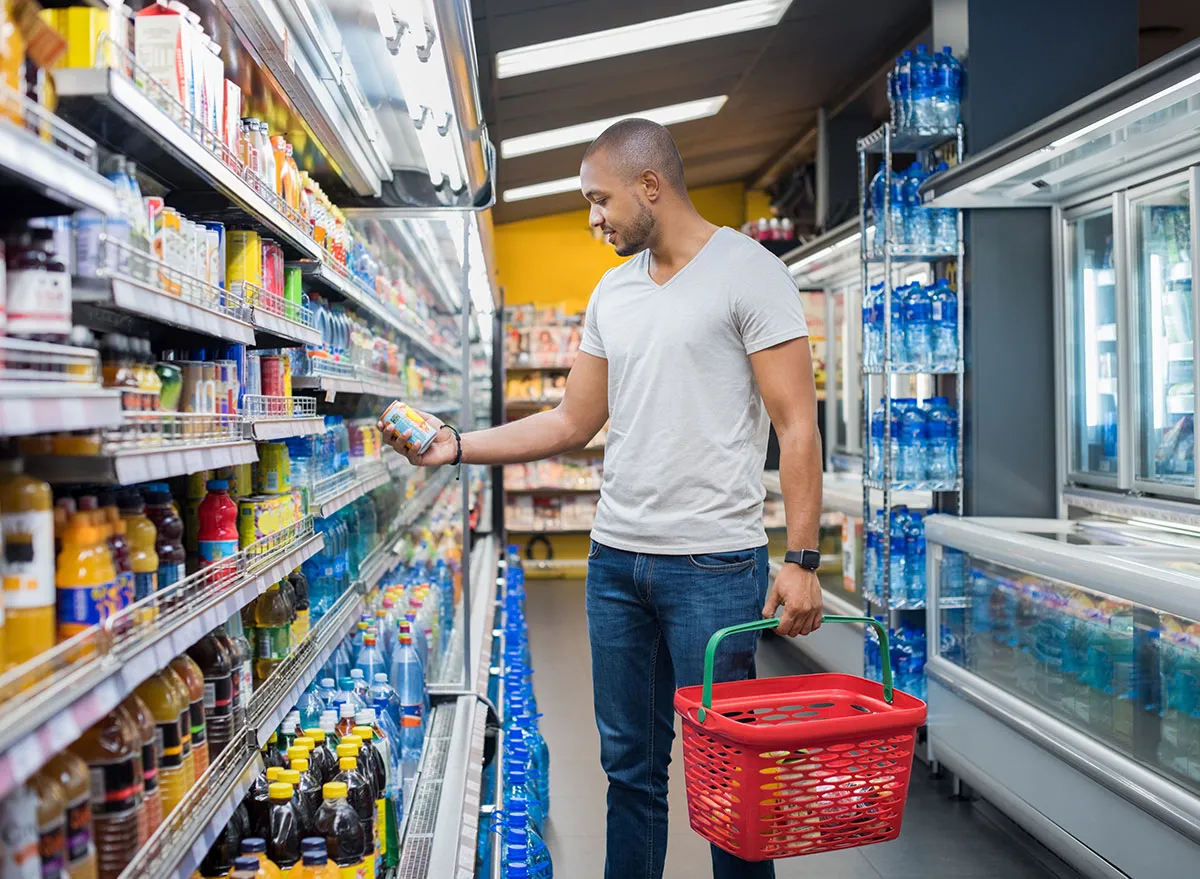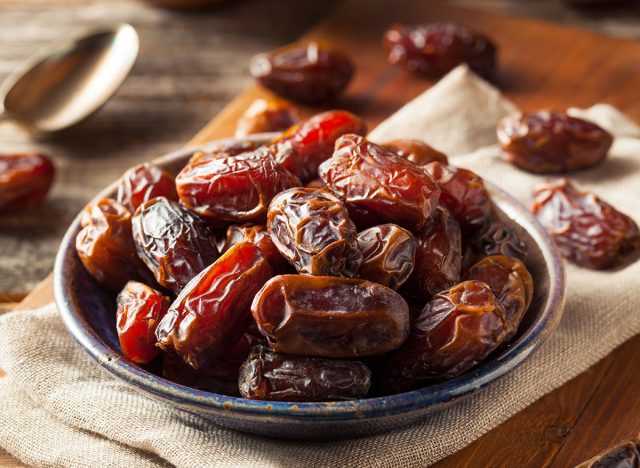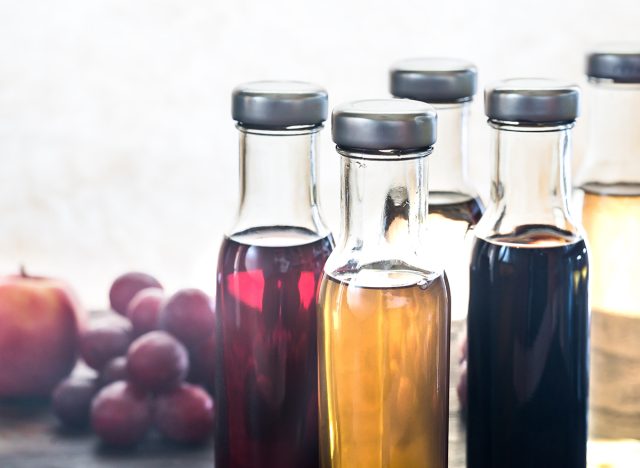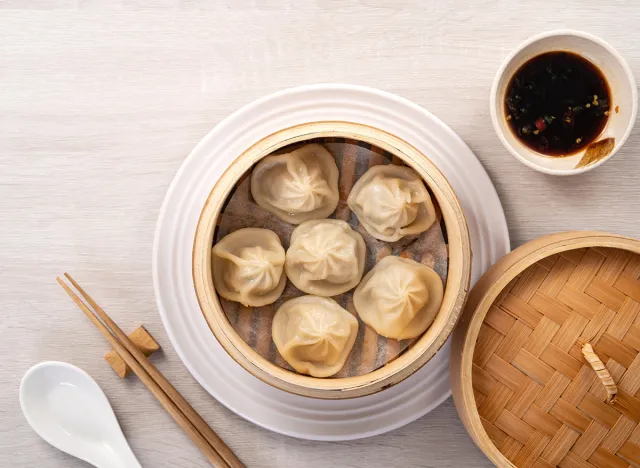7 Grocery Trends You’ll See Everywhere in 2025

At the end of each year, grocery store chains and trade associations release end-of-year predictions on which food trends will rule the aisles in the year ahead. In 2024, forecasters predicted that food and drinks, including mushrooms, functional beverages, and cacao, would be top of mind for shoppers.
This past year was all about health and wellness, and trend forecasters expect shoppers to gravitate toward those categories even more in the coming year.
To find out which specific food trends are worth your attention, we spoke to experts and scoured a half dozen yearly reports outlining predictions for the coming year. Here are seven of the most compelling grocery trends you’ll want to seek out in 2025—read on to find out more about each one.
2025 Grocery Trends:
- Hydration Enhancers
- Protein-Forward Snacks
- Functional Foods
- Natural Sweeteners
- Vinegars
- Dumplings
- Next-Gen Grocery Tech
Hydration Enhancers

There’s certainly a time and place for plain ol’ water, but in 2025, trendspotters expect to see shoppers lean into more exciting ways to hydrate. Electrolyte popsicles, chlorophyll water, and even cactus water are all on the table, according to Whole Foods’ annual report. And, notably, shoppers are consulting the ingredients list.
“Customers are being a little bit more critical about what they are hydrating with,” says Cathy Strange, ambassador of food culture at Whole Foods. “They may say, ‘I’m low on electrolytes, but I don’t really want that much sugar or artificial ingredients.’”
Hydration drink purveyors seem to be getting the hint, as brands ditch sugar-laden ingredients, instead opting for healthier alternatives like organic sports drinks with natural coconut, for example. Strange says the options in this space are exciting. “It’s almost endless,” she says. “We’re seeing cacao water, hemp water—it’s evolving to have really great flavors.”
Protein-Forward Snacks

High-protein food was identified as a trend to look out for in 2024, and prognosticators with Kroger and Fresh Thyme suggest that protein-packed goodies will remain on grocery store shelves into 2025, but with a twist. Protein has gone beyond the meat aisle: increasingly, shoppers will see protein-enhanced chips, cereals, cookies, pasta, and more.
“10 years ago, you probably weren’t looking at the protein content on your chips,” says Alexandra Trott, Director of Insights at 84.51°, a retail data science, insights, and media company. “I don’t think there’s really a limit on where people are looking for [protein] now, but it’s certainly a benefit that people want called out. Because the belief now is that protein is what sustains you throughout the day and that’s a healthy way to fill you up.”
Grocery chain Kroger expects plant-based protein in particular to be a category to watch. “In 2025, we’ll see a growing list of protein sources to include items like lentils, beans and hemp seeds,” a Kroger spokesperson said. “As customers seek ways to incorporate more protein and satiating foods to their plates, these plant-based additions are the perfect solution.”
“Adding protein to non-traditional protein sources like cereals, pasta and even sauces are an easy way to help consumers add extra protein to their food so that they feel full and satisfied after each and every snack or meal,” says Meghan Sedivy, Fresh Thyme Market’s registered dietitian. Shoppers who are looking for an easy way to boost their protein intake will likely seek out this trend in 2025.
Functional Foods

If there’s one common theme for shoppers—especially younger shoppers—it’s making sure the food they buy actually does some heavy lifting when it comes to hydration or nutrition. “We survey 400 shoppers every month,” says 84.51’s Trott, “For the 18 to 34 age bracket, the number one thing they’re looking for is functional benefits—whether it helps them calm down, helps with their digestion, or helps them hydrate—it has to have something that it’s doing for them.”
A report by the nonprofit Speciality Food Association (SFA) predicts the functional food category will grow into 2025, with an emphasis on foods that support cognitive health, emotional well-being, and overall wellness. This could include adaptogens, nootropics, and mood-enhancing botanicals. Leana Salamah, SFA’s senior vice president of marketing and communications, says this trend has evolved over the years. “It’s gone a step further to say, what can be added to the food that actually enhances it beyond its natural healing and functional properties,” she says.
“People are paying attention to their health and thinking a lot more about long-term wellness. We are living longer than ever, and we’re trying to marry that with living better than ever for longer than ever,” she says. With this in mind, expect to see more wellness teas, foods and drinks featuring manuka honey, and yes, mushroom-enhanced beverages.
Natural Sweeteners

According to registered dietician Sedivy, natural sweeteners are having a moment. “Specifically dates, which contain fructose, a type of sugar found in fruit,” she says. “They also contain fiber, which counteracts the natural sugar, allowing it to slowly be absorbed and help prevent spikes in blood sugar followed by quick crashes.”
In addition to dates, shoppers should expect honey, maple syrup, and even mashed bananas on the ingredients lists, instead of refined and processed sugars. “Many consumers are moving to lower sugar options as a part of living a healthier lifestyle,” says Sedivy. “Maple syrup, for example, contains magnesium and other minerals that help to promote muscle and nerve function, while honey contains antioxidants and anti-inflammatory properties to promote immune health.”
Vinegars

Vinegar is another food item that’s expected to be hot in 2025, and shoppers will get experimental in how they use it in their meals. SFA trendspotters say shoppers will branch out beyond the classic white, balsamic, and apple cider vinegars to try out new uses and flavors, including reductions, fruity condiments, and even drinking vinegars.
“There’s a lot of movement towards health and wellness, and vinegar as a fermented food does have a bit of a halo around this idea,” says Salamah. “Manufacturers have gotten so incredibly creative with what they’re making vinegar out of—everything from black cherry to chestnut and honey vinegar, and cucumber.” That creativity is expected to continue into 2025, as Salamah says it’s a quick and easy way to add an unexpected splash of flavor to just about anything. “For people trying to get creative in the kitchen, vinegar is a really fun way to add to, or to change the flavor profile of a meal,” she says.
Dumplings

For those who love seeking out the latest and greatest in the freezer aisle, expect to see innovative and creative twists on dumplings. Pocket foods, as they’re known, are showing up in the shelf-stable section of the grocery store, too, like soup dumplings. Historically, dumplings have been an easy way to explore international flavors in a quick and easy format.
Shoppers are looking for convenience and easy snacks with heaps of flavors, and Whole Foods’ Strange says dumplings fit perfectly into that category. “It’s just how to get a bite of something, without investing a whole meal, and the unique spices that can fit in a small bite,” she says. “You’re not having to prepare a whole meal to get those flavors—it’s the grab and go aspect of, let me try two or three of these, and if it doesn’t work out, it’s onto the next thing.”
In 2025, shoppers will see innovation when it comes to dumplings, whether it’s more familiar ingredients, like stuffed ravioli, or international fares, like bao bites, shawarma bites, or butter chicken bites. Vegan and plant-based dumplings will continue to rise, too.
Next-Gen Grocery Tech

If there’s one aspect of grocery shopping that’s due for some innovation come 2025, it’s the online shopping experience. Online grocery shopping is projected to reach around 20.5% of total grocery sales by 2026, and trend forecasters expect market leaders like Walmart, Target, and Kroger to improve their fulfillment models and leverage new tech to respond to this growing segment.
According to PJ Stafford, senior vice president of sales in Phononic‘s cold chain division, catering to hybrid shoppers—those who do both in-store and digital shopping—is top of mind for grocers. Above all, shoppers want convenient services that actually fit their lifestyles.
“If you’re at the office from eight to six, and you need a delivery slot after seven o’clock at night, which is limited, home delivery may be less attractive to you,” Stafford says. “But if you can swing by the supermarket on the way from dropping the kids off at school, or on the way home from work and go through a pickup lane, it becomes very attractive, particularly if it’s offered for free.”
Stafford says grocery stores across the country are improving in other areas, too, like leveraging automation to pick online orders and using temperature-controlled delivery totes, like Phononic’s, to eliminate the possibility of melted ice cream or perishables going bad in the back of a hot trunk. “The rise of hybrid shoppers and the fact that grocers are getting better at online orders—that’s a big one.”